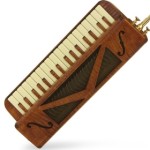My dream melodica
Tagged: Melodica Design
- This topic has 24 replies, 9 voices, and was last updated 8 years, 10 months ago by
 Alan Brinton.
Alan Brinton.
-
AuthorPosts
-
April 19, 2015 at 11:45 am #4743
 DarenKeymaster
DarenKeymasterInspired by recent posts, I thought I’d start a new discussion. At the moment I predominantly use one melodica (Yamaha P37D, or it’s little brother), but will occasionally swap to Clavietta or Vibrandoneon for a recording if the Yamaha sounds too raw.
Having said that, I still dream of having one instrument for everything, and believe that what I’m looking for is achievable. For me, this ideal instrument would have the light weight, response and compact dimensions of the Yamaha, along with its small air chamber. But the reeds would be in-between accordion and harmonica reeds. They would be made by experienced reed makers specifically for this use. The sound would be more polished, warm and clear than the Yamaha, with a sweet upper register. But all this without loosing the ability to play with ease. The reeds would stay in tune and rarely break, and the instrument would be robust and good looking.
I know there’s been some good quality melodicas, namely the Vibrandoneon and Eolina, but for me they still fall short of an ideal instrument. The tone and looks are good, but they’re bulky, heavy and difficult to play. Wooden air chambers and moisture just don’t go together, and result in mould and parts falling off.
Out of necessity, I’m looking into the possibility of developing this ideal instrument. It means a large amount of research and experimentation on reeds, which I think should be at the core of the design. The reed chamber would ideally be plastic, probably with a wooden outer case which would serve the dual purpose of mellowing the sound and looking beautiful.
I’m visualising a simple, quality, compact instrument, concentrating on basic tone and playability above any bells and whistles. How does this resonate with everyone else? I’m interested in how others are visualising their dream instrument…
April 20, 2015 at 8:14 pm #4764 LowboyParticipant
LowboyParticipantHi Daren,
In addition to my thoughts from a previous post noted below, here are some other attributes and affirmations of your ideas that I would like to see in my dream melodica:
I agree with your thoughts about relatively light weight (compared to a Vibrandoneon), but I would not sacrifice tone for light weight. I do like my instruments to feel professional and well-constructed. I should be able to drop it on cement and know it will still play.
The “. . . response and compact dimensions of the Yamaha, along with its small air chamber.” Absolutely.
“The sound would be more polished, warm and clear than the Yamaha, with a sweet upper register. But all this without losing the ability to play with ease. The reeds would stay in tune and rarely break, and the instrument would be robust and good looking.” I like all of that too.
Ease of maintenance would be great. Must be able to easily replace reed plates and gaskets. Do it right. Use o-rings.
Here are thoughts condensed from my January 18, 2015 post:
1. Sound holes on the back so that volume and timbre can me modulated by moving the melodica towards and away from your chest and stomach.
2. Create some melodicas with a darker, smoother timbre.
3. Similar to the Suzuki Pro37v2 melodion, consider creating a single sound hole at the bottom of the instrument, perhaps with an internal or external trumpet-like bell. Insulate the instrument so that all sound is emitted from the bell or sound hole. Provide a means for holding the instrument at the sound hole and enabling the player to cup and uncup the sound hole with her hand to module volume and timbre.
4. Design reeds or the instrument so that you can bend notes easier. Make them part of replaceable reed plates so that when the player blows out a reed, they can easily replace the reed plate. (Make big money selling replacement reed plates every couple of months to us players that love to play hard and bend notes.)
5. Provide an extra set of channels (or an internal valve) and a button to press that will enable us to draw as well as blow. (Think accordion, harmonica.)
6. Make a “blues” keyboard harmonica.
7. Create channels that will direct some of the air at an angle to the reed to enhance bending, or give us a button that will change the flow of air at the reed to enhance bending.
Regards,
Lowboy
April 20, 2015 at 9:40 pm #4766 OfirParticipant
OfirParticipantI read quite a lot about the small air chamber of the Yamaha. Owning this instrument, I agree that it has a beautiful response due to that.
While reading others complaining about other instruments with bigger air chamber (piano 36? pro 36?) yet having superior sound, I had a thought: is it possible to reduce the size of the air chamber by artificially adding material into it?
I don’t know how’s the water situation in your country, but the situation in mine is not the best. I ran into an idea few years ago which aims to reduce the capacity of the toilet flush tank by adding a bottle filled with water into it. That way this 1.5~2 litter of water is always there and is never flushed, making the toilet consume 1.5~2 litters less on each flush.Then the obvious suggestion would be to add a small plastic box glued inside the air chamber, just to make it smaller.
I waited to get my Pro 36 in order to test this idea theoretically (and the need practically), but as you started this post I just had to take it out.
April 21, 2015 at 6:42 am #4773 QuetscherParticipant
QuetscherParticipantIt would at least be very interesting to find out in which way a bigger or smaller air chamber influences the sound. I strongly suspect that apart from the reeds it is the bigger air chamber that causes the rounder and warmer sound of some instruments…
April 21, 2015 at 6:43 am #4774 QuetscherParticipant
QuetscherParticipantIt would at least be very interesting to find out in which way a bigger or smaller air chamber influences the sound. I strongly suspect that apart from the reeds it is the bigger air chamber that causes the rounder and warmer sound of some instruments, so perhaps you will have to find a compromise between sound and playability…
April 21, 2015 at 10:22 am #4778 OfirParticipant
OfirParticipantI believe that it can partly be tested using longer pipes, although we must address the following issue:
It is clear that the air pressure will eventually equal in the extended chamber (air chamber + pipe). However, using longer pipes (vs. just a bigger air chamber) will probably differ in the pressure waves moving on a new phrase (or on each new note).Using my own experience, I’m getting a smoother tone using my Yamaha with a pipe, compared with a mouthpiece.
April 21, 2015 at 7:48 pm #4782 DarenKeymaster
DarenKeymasterLowboy, thanks for all your ideas and suggestions. Great to talk to someone who’s clearly been thinking about this for a while! Your ideas are all very creative. I suppose it’s a matter if incorporating whatever I can into a neat design. Your idea:
“…creating a single sound hole at the bottom of the instrument, perhaps with an internal or external trumpet-like bell. Insulate the instrument so that all sound is emitted from the bell or sound hole. Provide a means for holding the instrument at the sound hole and enabling the player to cup and uncup the sound hole with her hand to module volume and timbre”
could really help with harmonica-like expression if it can be included while easily gripping the instrument. Bendable reeds would also be great, but I imagine my research won’t go that far for the next instrument. I’ve already got quite a long checklist!
I think, once I’ve got the basics right, e.g. tone, size, playability etc, I might be able to then branch out into adding more capabilities.
Ofir, I reduced the air chamber size of my Vibrandoneon Mk I. It had 2 reed banks, but I only used one, so I didn’t see the point in having to work so hard to fill up such a huge chamber. I did it with foam and gaffer tape, and it worked well! No discernible difference in the sound, but then again, the outer casing was still the same size.
Quetscher, you said:
“It would at least be very interesting to find out in which way a bigger or smaller air chamber influences the sound. I strongly suspect that apart from the reeds it is the bigger air chamber that causes the rounder and warmer sound of some instruments, so perhaps you will have to find a compromise between sound and playability…”
I agree that the air chamber size will make a difference to the sound, and there may be some compromise involved. I think it can be compensated for through the shape and material of the outer casing though. So maybe not a traditional accordion tone, but hopefully a beautiful melodica tone 🙂
April 22, 2015 at 10:41 pm #4788 Melodica-MeParticipant
Melodica-MeParticipantDaren, the only two items I would add to LowBoys Dream Melodica wish list is (#1) if the sound could not be forced through a bell at the end of the melodica then maybe the reeds can be segregated in a channel or pipe (Brass) almost like the Hohner Claviola where you can create the same wah-wah effect there. (#2) If possible, design a bar with magnets into the back side of the reed plate to slide across the reeds and using the “magnetic field” to force the reed back to create a semi tone bend like the one used on the Turbo Harp. Oh and a built in Mic is always a plus. 🙂
Melodica-Me
April 23, 2015 at 3:44 am #4791 Shannon MParticipant
Shannon MParticipantSince we are dreaming, all of the above, the smooth keyboard action of the pro 36, and it costs less than $100. 8^)
Shannon
April 23, 2015 at 4:03 am #4792 Alan BrintonParticipant
Alan BrintonParticipantMetal tray.
April 24, 2015 at 2:33 am #4795 Shannon MParticipant
Shannon MParticipantAlso, how about an easily replaceable reed block or plate, to allow a change in “character” of tone. Warmer, bluesier, cleaner, tremolo, etc. I am also thinking sound holes on top (melodic would be a little wider) would make wah-wah easier than on the bottom. The end trumpet already suggested might be the best answer for that, though.
Shannon
April 25, 2015 at 2:12 pm #4821 DarenKeymaster
DarenKeymasterLots of interest in wah wah capabilities then! I have an original accordion which has sprung sides which can be manipulated to produce a change of tone. I don’t really use it though, because the change in timbre isn’t as dramatic as you’d get in a harmonica. But definitely something to consider while designing.
I’m still interested in focusing on a simple robust melodica with top quality sound as the main priority. I’m not sure anyone’s successfully achieved that yet. Any extra features will ultimately add to more bulk, weight, and the potential of more things going wrong.
Shannon, I like the idea of interchangeable reeds, to change character, or even to change from an alto to a soprano range. Or maybe it’s simpler to just have a range of instruments?
Alan, a metal tray would certainly add to the robustness. I’m going to experiment with wood first, because I want to get a real feel for what different timbers add to the sound.
MM, I’ve though more about the magnets, (https://melodicaworld.com/forums/topic/bending-notes-on-melodica-with-magnet-slide) and they’re just too complicated for now. I’ve got to stay focused! Simple, beautiful, compact, robust 🙂
April 25, 2015 at 2:46 pm #4822 OfirParticipant
OfirParticipantDaren,
I agree that the focus should first be on top quality instrument as you mentioned, and any other feature is a nice bonus for future considerations.
Let’s design and build the Steinway of melodicas!April 25, 2015 at 3:35 pm #4823 DarenKeymaster
DarenKeymasterI love your description, ‘The Steinway of Melodicas’! This is indeed what I aim to create 🙂
April 25, 2015 at 6:57 pm #4824 QuetscherParticipant
QuetscherParticipantHi Daren, hi Ofir,
The “Steinway of melodicas “ sounds good, but I’d focus on the melodica as a wind instrument, not as a keyboard instrument – and so, after (of course) having found the sound that suits (for me, it would be a sound similar to the clavietta which touches me strongly), I would do anything to make the instrument as flexible as possible – with bendings, blowing techniques, WahWah’s etc. This means I’d work hard on mouthpieces, on ways to ease bendings and on ways to muffle the sound.
As you know I’m a big friend of accordion style instruments because this kind of construction seems to allow better WahWah’s and better bendings, but of course I’m aware of the flaws of this construction, especially the bulkiness. That’s why my dream melodica should have a neck strap or shoulder straps (which is what I attached to my Vibrandoneon) so I wouldn’t have to care about the weight. But then you need fitting mouthpieces; and of course you will not be able to have a look at the keyboard while playing. So my dream melodica will certainly not be everyone’s dream melodica!
Greetings, Quetscher
-
AuthorPosts
- You must be logged in to reply to this topic.
